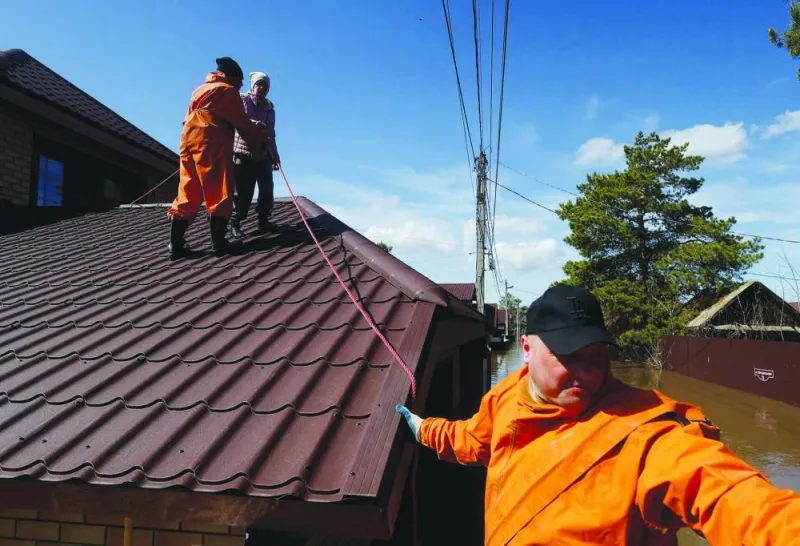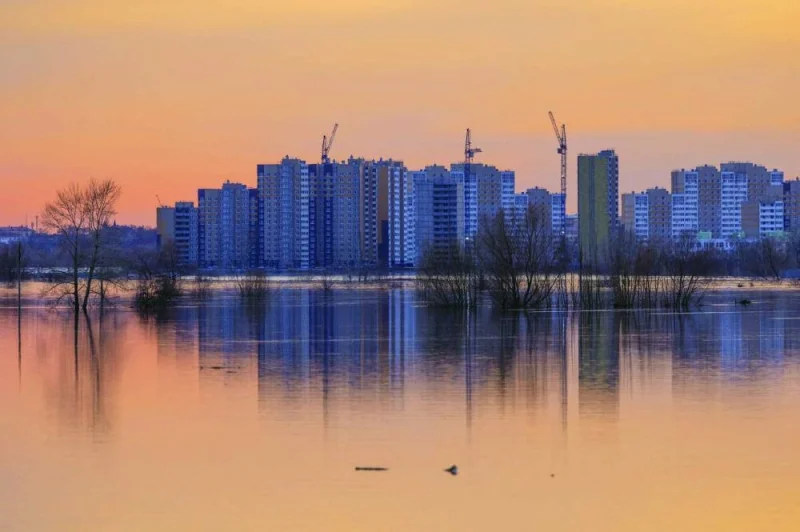The Russian city of Orenburg battled rising water levels on Thursday after major rivers across Russia and Kazakhstan burst their banks in the worst flooding seen in the areas in nearly a century.
The deluge of melt water has forced over 120,000 people from their homes in Russia’s Ural Mountains, Siberia and Kazakhstan as major rivers such as the Ural, which flows through Kazakhstan into the Caspian, overwhelmed embankments.
Residents in the city of Orenburg said the waters of the Ural rose swiftly and to far beyond breaking point, forcing them to flee with just their children, pets and a few belongings.
“It came very quickly at night,” Taisiya, 71, told Reuters in Orenburg, a city of 550,000 about 1,200km (750 miles) east of Moscow.
“By the time I got ready, I couldn’t get out,” she said.
Whole areas of the city were underwater, and the Ural rose swiftly to 10.87m (more than 35’), far above the level considered by local authorities as safe.
Orenburg Governor Denis Pasler told President Vladimir Putin that the situation had peaked, adding however that water levels would still rise.
He said that 11,972 homes had been flooded and if waters rose further 19,412 more people would be in danger.
The flooding has struck Russia’s Urals and northern Kazakhstan worst, though waters are also rising in southern parts of Western Siberia, the largest hydrocarbon basin in the world, and in some places near the Volga, Europe’s biggest river.
Water levels were also rising in Siberia’s Tyumen, where 7,291 people were evacuated, and in Kurgan, where 6,151 people were evacuated.
The flooding of the Ishim river in Russia’s Tyumen region is due to peak by April 23-25.
After the Ural burst through dam embankments in Orsk, upstream from Orenburg, last Friday, some residents expressed anger over how local officials had handled the situation, demanding greater compensation and begging for help from Putin.
Putin held a video meeting with Emergencies Minister Alexander Kurenkov and the governors of Orenburg, Kurgan and Tyumen, the worst affected regions.
In Orenburg, some residents expressed disappointment that the local officials had not done enough to prepare for the annual snow melt.
In his first public comments on the floods, Putin told officials to focus on helping people.
“In some places the water has not arrived yet and in other places it has not flowed away yet, but we need to think right now on how to rebuilding housing,” the president said.
Spring flooding is a usual part of life across Russia – which has an area equal to the United States and Australia combined – as the heavy winter snows melt, swelling powerful rivers in Russia and Central Asia.
This year, though, a combination of factors triggered unusually severe flooding, according to emergency workers.
They said soils were waterlogged before winter and then were frozen under deep snow falls which melted very fast in rising spring temperatures and heavy rains.
Climate researchers have long warned that rising temperatures could increase the incidence of extreme weather events, and that heavily forested Russia is of major importance in the global climate equation.
In Kurgan, a region which straddles the Tobol river, water levels are rising.
About 14,000 workers were working around the clock to raise the 30km long Kurgan embankment, Governor Vadim Shumkov said.
In the city of Kurgan water levels are at just under 4m, Shumkov said.
Kazakhstan has also been badly hit.
The emergencies ministry said on Thursday that the number of evacuees stood at over 98,000, and a state of emergency remained in effect in eight regions of the country.
Emergency workers have removed 8.8mn cu m (310mn cubic feet) of water from flooded areas, the ministry said.
The Kazakh government said movement was restricted on hundreds of kilometres of roads in the Aktobe, Akmola, Atyrau, Kostanai, Mangistau and North Kazakhstan regions.

A resident is evacuated by members of Kirov’s Regional Fire and Rescue service in Orenburg.

Right: A road sign is seen at the entrance to the flooded residential area in Orenburg, Russia.

A general view shows a flooded area during sunset in Orenburg, Russia.

In this pool photograph distributed by the Russian state agency Sputnik, Russia’s President Vladimir Putin chairs a meeting on flood response efforts in various regions of Russia.
